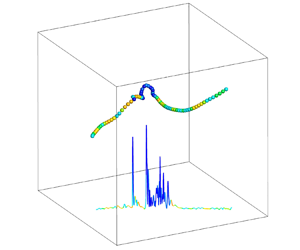Published online by Cambridge University Press: 03 February 2022

The accelerations of tracer and light particles (bubbles) in compressible homogeneous isotropic turbulence are investigated by using data from direct numerical simulations up to turbulent Mach number  $M_t =1$. For tracer particles, the flatness factor of acceleration components,
$M_t =1$. For tracer particles, the flatness factor of acceleration components,  $F_a$, increases gradually for
$F_a$, increases gradually for  $M_t \in [0.3, 1]$. On the contrary,
$M_t \in [0.3, 1]$. On the contrary,  $F_a$ for bubbles develops a maximum around
$F_a$ for bubbles develops a maximum around  $M_t \sim 0.6$. The probability density function of longitudinal acceleration of tracers is increasingly skewed towards the negative value as
$M_t \sim 0.6$. The probability density function of longitudinal acceleration of tracers is increasingly skewed towards the negative value as  $M_t$ increases. By contrast, for light particles, the skewness factor of longitudinal acceleration,
$M_t$ increases. By contrast, for light particles, the skewness factor of longitudinal acceleration,  $S_a$, first becomes more negative with the increase of
$S_a$, first becomes more negative with the increase of  $M_t$, and then goes back to
$M_t$, and then goes back to  $0$ when
$0$ when  $M_t$ is larger than
$M_t$ is larger than  $0.6$. Similarly, differences among tracers and bubbles appear also in the zero-crossing time of acceleration correlation. It is argued that all these phenomena are intimately linked to the flow structures in the compression regions close to shocklets.
$0.6$. Similarly, differences among tracers and bubbles appear also in the zero-crossing time of acceleration correlation. It is argued that all these phenomena are intimately linked to the flow structures in the compression regions close to shocklets.